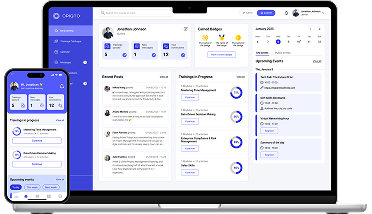Every training consists of dozens of pieces of content — modules, units, even entire courses — that need to be kept updated and delivered to learners throughout your organization.
This could include content from many sources, such as:
- You develop in-house content, such as product guides for your sales team or a presentation about company values for your new hire orientation.
- Third-party content you have purchased, such as a security awareness training or management training course.
- Open educational resources or educational content that is available for free from various sources around the Internet.
- This could be everything from written textbooks to interactive media and quizzes. The trouble is that it can be hard to keep track of all of this training content. Perhaps you have a collection of PowerPoint slide decks or a physical file folder full of product specifications documents.
Learning never exhausts the mind.
Leonardo da Vinci
How are you currently keeping track of it all?
Managing training content digitally
Digitizing your training content is one of the easiest ways to keep your content up-to-date. It can make your training content much more accessible — particularly if you have a large company or a scattered and remote workforce. It also reduces the need to store physical documents.
There are a number of manual ways to keep track of and deliver that digital training content. For example, you can use a central server or dropbox folder to store the content for individual courses. This is a good way to keep all your training content in one central place, allowing you to keep your training modules current without tracking down content in multiple locations.
Of course, it can be difficult to manage and track who has read what content this way, and it may not always be clear in which order the different pieces of content should be consumed.
Using an LMS to manage training content
The easiest way to manage all your digital content and deliver it efficiently is within a learning management system (LMS). A flexible LMS allows you to organize all your various pieces of training content into a larger course.
An LMS also lets you control the learner’s journey through the content. For example, you could upload a PDF of a product booklet for the learner to read, then follow that with an interactive quiz to help cement their knowledge. You can even use the LMS to create adaptive learning paths within a training in order to deliver individualized content to each learner.
A good LMS will let you integrate any training contact you may have purchased or found elsewhere, which is a great way to personalize external resources with modules that you create in house in order to tailor it more toward your organization’s needs.
Your LMS can also allow you to use blended learning, combining both instructor-led sessions and e-learning content to more fully engage your learners.
Are you still struggling to keep track of training content and deliver it to your learners? Get in touch today and learn more about how Opigno LMS can help make managing your training contact easy.
Published on April 19, 2021
